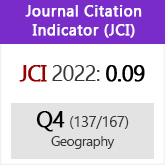Approximation to the spatial structure of financial derivative transactions in the otc over-the-counter market
DOI:
https://doi.org/10.3989/estgeogr.202077.078Keywords:
Financial geography, over the counter, capital flows, geoeconomics, financial contagion, swaps, regulation, financial locationAbstract
This paper aims to identify some features of the spatial network of international financial relations in the over-the-counter derivatives market. Its territorial structure has been reconstructed through the 2019 Triennial Survey of Global Derivatives Markets of the Bank for International Settlements, which provides information disaggregated by states and currencies in the contracts signed, making it possible to establish the main characteristics of this financial market.
There is a high concentration of contracts signed in the financial centres of the United Kingdom and the United States, with Hong Kong as the third emerging market. Data from recent years reveal that the UK has tripled the value of this market since the Brexit referendum in 2016, highlighting its international solvency as a financial market of reference, and that the exit from the EU is not harming its global position.
There are several factors that determine the location of hedge funds: an Anglo-Saxon regulatory environment, differences between states in the conditions of legal guarantees, asymmetric information, and the development of herding techniques are some of the conditions that determine the location and morphology of capital flows. Research into the spatial structure of the global financial network can improve knowledge of the process of contagion between territories, and introduce mitigating measures linked to greater control of the regulatory framework of global financial flows.
Downloads
References
Aalbers, M. B. (2015). Financial geography: introduction to the virtual issue. Transactions of the Institute of British Geographers, 40(2), 300-305. https://doi.org/10.1111/tran.12081
Aalbers, M. B. (2016). Corporate financialization. International Encyclopedia of Geography: People, the Earth, Environment and Technology: People, the Earth, Environment and Technology, 1-11. https://doi.org/10.1002/9781118786352.wbieg0598 PMid:29076310
Abad, J., Aldasoro, I., Aymanns, C., D'Errico, M., Rousová, L., Hoffmann, P., y Roukny, T. (2016). Shedding light on dark markets: First insights from the new EU-wide OTC derivatives dataset (nº11). ESRB Occasional Paper Series.
Agnes, P. (2000). The "end of geography" in financial services? Local embeddedness and territorialization in the interest rate swap industry. Economic geography, 76(4), 347-366. https://doi.org/10.2307/144391
Algieri, B. (2018). A Journey Through the History of Commodity Derivatives Markets and the Political Economy of (De) Regulation. ZEF-Discussion Papers on Development Policy, (268). https://doi.org/10.2139/ssrn.3301143
Barth, M. E., y Landsman, W. R. (2010). How did financial reporting contribute to the financial crisis? European accounting review, 19(3), 399-423. https://doi.org/10.1080/09638180.2010.498619
Bauer, R., Bonetti, M., y Broeders, D. (2018). Pension funds interconnections and herd behavior. Working Paper nº 612. De Nederlandsche Bank. Recuperado de https://cris.maastrichtuniversity.nl/en/publications/70289833-cc7a-4bc3-8afc-83adb399347a
Boddy, M. J. (1976). The structure of mortgage finance: building societies and the British social formation. Transactions of the institute of British Geographers, 58-71. https://doi.org/10.2307/621313
Bonizzi, B., y Kaltenbrunner, A. (2019). Liability-driven investment and pension fund exposure to emerging markets: A Minskyan analysis. Environment and Planning A: Economy and Space, 51(2), 420-439. https://doi.org/10.1177/0308518X18794676
BPI (2019). OTC interest rate derivatives turnover in April 2019. Triennial Central Bank Survey. Recuperado de https://www.bis.org/statistics/rpfx19_ir.pdf
Cheung, Y. W., McCauley, R. N., y Shu, C. (2019). Geographic spread of currency trading: the renminbi and other EM currencies. BIS Working Papers nº 806. https://doi.org/10.1111/cwe.12292
Clark, G. L. (2006). Setting the agenda: the geography of global finance. In Economic Geography (pp. 105-115). Routledge. Recuperado de https://ora.ox.ac.uk/objects/uuid:3d2d3e4c-9bbb-42a8-9c99-0535fa920c40
Clark, G. L. (2017). Financial intermediation, infrastructure investment and regional growth. Area Development and Policy, 2(3), 217-236. https://doi.org/10.1080/23792949.2017.1345641
CNMV (2006). Estudio sobre los hedge funds. Servicio de Publicaciones de la Comisión Nacional del Mercado de Valores. Recuperado de https://www.cnmv.es/DocPortal/Publicaciones/OTROS/HedgeFunds_02_2006.pdf
Crotty, J. (2009). Structural causes of the global financial crisis: a critical assessment of the 'new financial architecture'. Cambridge Journal of Economics, 33(4), 563-580. https://doi.org/10.1093/cje/bep023
Daher, A. (2016). Externalidades territoriales de la gobernanza financiera global. EURE. Santiago de Chile, 42 (126), 213-236. https://doi.org/10.4067/S0250-71612016000200010
D'Avino, C. (2017). Banking regulation and the changing geography of off-balance sheet activities. Economics Letters, 157, 155-158. https://doi.org/10.1016/j.econlet.2017.05.035
Duffie, D., y Hu, H. T. (2008). Competing for a share of global derivatives markets: trends and policy choices for the United States. University of Texas Law, Law and Economic Research Paper, (145). https://doi.org/10.2139/ssrn.1140869
Dymski, G. A. (2017). Making Financial Instability Visible in Space as Well as Time. Money and Finance After the Crisis: Critical Thinking for Uncertain Times, 91. https://doi.org/10.1002/9781119051374.ch4
ESMA (2019). Directrices sobre el cálculo de posiciones por los registros de operaciones en virtud del Reglamento relativo a los derivados extrabursátiles, las entidades de contrapartida central y los registros de operaciones (EMIR). Recuperado de https://www.esma.europa.eu/sites/default/files/library/esma70-151-1350_guidelines_on_position_calculation_by_trs_under_emir_es.pdf
Fernández Cela, J. C. (2015). Estructura espacial de los flujos de Inversión Exterior Directa en España. Primeros pasos para la elaboración de una cartografía financiera. Geopolítica (s), 6(1), 107-136. https://doi.org/10.5209/rev_GEOP.2015.v6.n1.47546
Fernández Cela, J. C. (2015b). Geografía de la deuda pública española. Algunas consideraciones espaciales desde la perspectiva política. Boletín de la Asociación de Geógrafos Españoles, (67). Recuperado de https://eprints.ucm.es/id/eprint/50955/ https://doi.org/10.21138/bage.1822
Fernández Cela, J. C. (2019). Estructura espacial de los centros financieros offshore en Europa. Boletín de la Asociación de Geógrafos Españoles, (80).
Ferri-Ricchi, A. (2013). El contrato de swap como tipo de derivado. Tesis doctoral. Universidad Complutense de Madrid. Recuperado de https://eprints.ucm.es/22814/1/T34726.pdf
Fichtner, J. (2016). The anatomy of the Cayman Islands offshore financial center: Anglo-America, Japan, and the role of hedge funds. Review of International Political Economy, 23(6), 1034-1063.3. https://doi.org/10.1080/09692290.2016.1243143
Fisanotti, L. (2014). Antecedentes Históricos de los Mercados de Futuros y Opciones: Cobertura y Especulación. Invenio, 17(33), 9-19. Recuperado de https://www.redalyc.org/pdf/877/87732404002.pdf
Fung, W., y Hsieh, D. (2004). Hedge Fund Benchmarks: A Risk Based Approach. Financial Analyst Journal 60:65-80. https://doi.org/10.2469/faj.v60.n5.2657
Gandré, P., Mariathasan, M., Merrouche, O., y Ongena, S. (2020). Unintended Consequences of the Global Derivatives Market Reform. Swiss Finance Institute Research Paper, (20-02). https://doi.org/10.2139/ssrn.3518411
Harvey, D. (1974). Class-monopoly rent, finance capital and the urban revolution. Regional Studies, 8(3-4), 239-255. https://doi.org/10.1080/09595237400185251
Hobson, J. A. (1902). Estudio del imperialismo. Alianza Editorial, Madrid, 1981.
Houston, J. F., Lin, C., y Ma, Y. (2012). Regulatory arbitrage and international bank flows. The Journal of Finance, 67(5), 1845-1895. https://doi.org/10.1111/j.1540-6261.2012.01774.x
Huang, W., Meoli, M., yVismara, S. (2019). The geography of initial coin offerings. Small Business Economics, 1-26. https://doi.org/10.1007/s11187-019-00135-y
Kalinowski, M. (2011). Over-the-counter derivatives market in view of the global financial crisis 2007-2009. Economics y Management, 16, 1124-1129. Recuperado de https://www.academia.edu/1769728/OVER_THE_COUNTER_DERIVATIVES_MARKET_IN_VIEW_OF_THE_GLOBAL_FINANCIAL_CRISIS_2007_2009
Kellard, N., Millo, Y., Simon, J., y Engel, O. (2017). Close communications: hedge funds, brokers, and the emergence of herding. British Journal of Management, 28(1), 84-101. https://doi.org/10.1111/1467-8551.12158
Marjosola, H. (2019). The problem of regulatory arbitrage: A transaction cost economics perspective. Regulation & Governance. https://doi.org/10.1111/rego.12287
Marquina, A. (2013). Los derivados financieros, su impacto en la seguridad alimentaria y los intentos de regulación. Revista UNISCI, (31), 149-170. Recuperado de http://www.redalyc.org/articulo.oa?id=76725704014 https://doi.org/10.5209/rev_UNIS.2013.n31.44761
McCauley, R. N., y Ito, H. (2018). A key currency view of global imbalances. Journal of International Money and Finance, 94, 97-115. https://doi.org/10.1016/j.jimonfin.2019.01.013
Méndez Gutiérrez del Valle, R. (2019). La telaraña financiera: Una geografía de la financiarización y su crisis Barcelona. Ril Editores.
Méndez Gutiérrez del Valle, R. (2020). Ciudades en venta: Estrategias financieras y nuevo ciclo inmobiliario en España (Vol. 21). Universitat de València.
Mihaljek, D., y Packer, F. (2010). Derivatives in emerging markets. BIS Quarterly Review, December. Recuperado de https://papers.ssrn.com/sol3/papers.cfm?abstract_id=1727412
Muellerleile, C. (2015). Speculative boundaries: Chicago and the regulatory history of US financial derivative markets. Environment and Planning A, 47(9), 1805-1823. https://doi.org/10.1068/a130343p
Nguyen, L. T., Sy, M. O., Cheng, M. Y., Hossain, S., y Chen, T. B. (2019). Are Funds of Hedge Funds Efficient? An Empirical Analysis for North American, Asia Pacific, and European Long/Short Funds of Hedge Funds. Multinational Finance Journal, 23(1-2), 37-64. Recuperado de https://econpapers.repec.org/scripts/redir.pf?u=http%3A%2F%2Fwww.mfsociety.org%2Fmodules%2FmodDashboard%2FuploadFiles%2Fjournals%2FMJ~0~p1dl1svd771e2vl581j588lpos4.pdf;h=repec:mfj:journl:v:23:y:2019:i:1-2:p:37-64
Ontiveros, E. (2017). Introspección global. Vulnerabilidad europea al aislacionismo y a los nuevos proteccionismos. Geoeconomías del s. XXI. CESEDEM, 93-138.
Roe, M. J. (2010). The derivatives market's payment priorities as financial crisis accelerator. Stan. L. Rev., 63, 539. https://doi.org/10.2139/ssrn.1567075
Satis Crypto (2018). Cryptoasset Market Coverage Initiation: Network Creation.
Schroeder, P. (2019). Big banks score win as U.S. regulator proposes easing post-crisis derivatives rules. Reuters Business News. Recuperado de https://www.reuters.com/article/us-usa-banks-swaps-idUSKBN1W2223
Skinner, F. S., y Townend, T. G. (2002). An empirical analysis of credit default swaps. International Review of Financial Analysis, 11(3), 297-309. https://doi.org/10.1016/S1057-5219(02)00077-7
Sokol, M. (2013). Towards a 'newer'economic geography? Injecting finance and financialisation into economic geographies. Cambridge Journal of Regions, Economy and Society, 6(3), 501-515. https://doi.org/10.1093/cjres/rst022
Teo, M. (2009). The geography of hedge funds. The Review of Financial Studies, 22(9), 3531-3561. https://doi.org/10.1093/rfs/hhp007
Uría Menéndez (2019). Servicios de inversión, gestión de activos e infraestructura de mercados. Boletín de Regulación Financiera. Recuperado de https://www.uria.com/documentos/circulares/1139/documento/8894/Boletin_Octubre_2019.pdf?id=8894
Vilariño, A. (2018). Regulación financiera y riesgos sistémicos bajo la hegemonía del capital financiero. Recuperado de https://www.researchgate.net/publication/325313973_Regulacion_financiera_y_riesgos_sistemicos_bajo_la_hegemonia_del_capital_financiero
Wójcik, D., MacDonald-Korth, D., y Zhao, S. X. (2017). The political-economic geography of foreign exchange trading. Journal of Economic Geography, 17(2), 267-286.
Zhang, H., y Kim, H. (2019). Foreign Bias of Sovereign Wealth Fund And Spatial Spillover Effects. The Singapore Economic Review, 64(02), 377-397. https://doi.org/10.1142/S021759081747004X
Z/yen (2019). Global Financial Centres Index.
Published
How to Cite
Issue
Section
License
Copyright (c) 2021 Consejo Superior de Investigaciones Científicas (CSIC)

This work is licensed under a Creative Commons Attribution 4.0 International License.
© CSIC. Manuscripts published in both the printed and online versions of this Journal are the property of Consejo Superior de Investigaciones Científicas, and quoting this source is a requirement for any partial or full reproduction.All contents of this electronic edition, except where otherwise noted, are distributed under a “Creative Commons Attribution 4.0 International” (CC BY 4.0) License. You may read here the basic information and the legal text of the license. The indication of the CC BY 4.0 License must be expressly stated in this way when necessary.
Self-archiving in repositories, personal webpages or similar, of any version other than the published by the Editor, is not allowed.
















